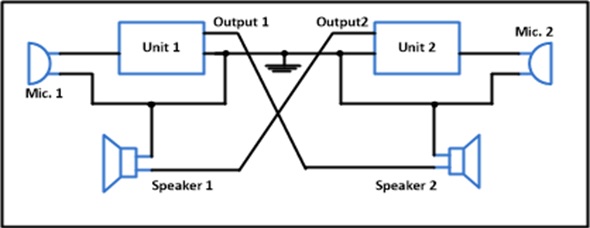Intercom is useful circuit that keeps you in touch with your family member present in another room without moving from your place. You can mount this circuit in outside area of your house like in garage, and you can this circuit for bidirectional communication.
[[wysiwyg_imageupload:11088:]]
Fig. 1: Prototype of Two Way Intercom Circuit on Breadboard
LM386 is a very popular and widely use 8 pin audio amplifier used to amplify sound signals. The circuit describe below can also be used to amplify the sound signals from mobile output, CD player or it can be used in cars to amplify sound signal.
To understand the working of circuit first we should understand its pin description-
Pin 1 and pin 8 is used for gain control of the amplifier.
Fig. 2: Pin Configuration of CA3130 IC
Pin 2 and pin 3 is used to feed the input signal which is required to be amplified. Pin 2 is used for negative input and pin 3 is for positive signal.
Pin 4 is used as ground.
Pin 6 is used to connect DC power supply.
Pin 5 is used as output.
Pin 7 is used as bypass terminal with a capacitor to prevent oscillation.
Working of this intercom circuit is very simple first we have to adjust its gain factor through pin 1 and 8 if it is left open the gain will be 20 as it is internally set in IC but it can be vary by adding a resistor and a capacitor up to 200. Now feed the required signals to pin 2 or 3. A resistor is connected to pin 3 to adjust the sensitivity of input signal and we will get output on pin 5.
C4 is used as current bank for output means when demand for current become low it supplies electrons or when sudden surges of current occur. C5 act as a coupling capacitor remove DC signals and passes only AC signals through it. And we will get the amplified signals through speaker.
The speaker volume can be adjusted with the help of variable resistor VR1.For the circuit to operate as two way intercom make two identical circuits as shown in circuit diagram. Now connect output of one unit to speaker of other unit and vice versa and use independent power supply for two units and connect them with 3 core wire, two wire for outputs and one wire for common ground is required for intercom connection. You can see from the below circuit how to connect the two units simultaneously.

Circuit Diagrams
Project Components
Project Video
Filed Under: Electronic Projects
Filed Under: Electronic Projects



Questions related to this article?
👉Ask and discuss on EDAboard.com and Electro-Tech-Online.com forums.
Tell Us What You Think!!
You must be logged in to post a comment.